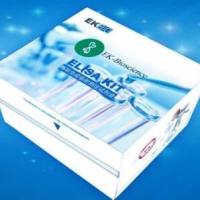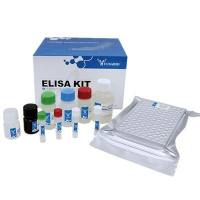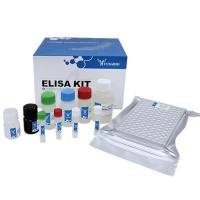Characterization of Tachykinin Receptors
互联网
- Abstract
- Table of Contents
- Materials
- Figures
- Literature Cited
Abstract
The mammalian tachykinin peptides are a family of neuropeptides characterized by a common C?terminal amino acid sequence of the form Phe?X?Gly?Leu?Met?NH2 , where X is either Phe or Val. Tachykinin peptides have various biological activities, including excitation of both peripheral and central neurons, stimulation of smooth muscle contraction, stimulation of exocrine and endocrine gland secretion, and involvement in immune and inflammatory responses. This unit presents basic methods for the characterization of tachykinin receptors by radioligand binding assay. The protocols detail methods for three major classes of tachykinin receptors and techniques for the generation of high specific activity iodinated radioligands.
Table of Contents
- Basic Protocol 1: Competition Binding Assay for NK1 or NK2 Receptor–Bearing Cells and Tissues
- Alternate Protocol 1: Competition Binding Assay for NK3 Receptor–Bearing Cells and Tissues
- Basic Protocol 2: Saturation Binding Assay for NK1 or NK2 Receptor–Bearing Cells and Tissues
- Alternate Protocol 2: Saturation Binding Assay for NK3 Receptor–Bearing Cells and Tissues
- Support Protocol 1: Radioiodination of the Tachykinin Peptides
- Support Protocol 2: Preparation of Membrane from Tissue Bearing Tachykinin Receptors
- Reagents and Solutions
- Commentary
- Figures
- Tables
Materials
Basic Protocol 1: Competition Binding Assay for NK1 or NK2 Receptor–Bearing Cells and Tissues
Materials
Alternate Protocol 1: Competition Binding Assay for NK3 Receptor–Bearing Cells and Tissues
Basic Protocol 2: Saturation Binding Assay for NK1 or NK2 Receptor–Bearing Cells and Tissues
Materials
Alternate Protocol 2: Saturation Binding Assay for NK3 Receptor–Bearing Cells and Tissues
Materials
Support Protocol 1: Radioiodination of the Tachykinin Peptides
Materials
|
Figures
-
Figure 1.15.1 Results from a representative competition radioligand binding experiment using [125 I]Tyr−1 ‐NKA as the radioligand (220,000 cpm/tube or 0.045 nM) and NKB as the competitor (concentrations are indicated). CHO cells expressing cloned rat NK2 receptor (700,000 receptors/cell) were used as the receptor source. The binding assay was performed as described (see ). (A ) Competition curve. (B ) Hill transformation plot (see step , ). Solving the equation when y = 0 gives x = log[IC50 ] = −7.3495; therefore, the IC50 for NKB = 44.7 nM. View Image -
Figure 1.15.2 Example of data output from a representative saturation equilibrium radioligand binding experiment using [3 H]senktide (concentrations are indicated). CHO cells expressing cloned human NK3 receptor were used as the receptor source. Nonspecific binding was defined with a 1000‐fold excess of unlabeled senktide. The binding assay was performed as described (see ). The inset is a Scatchard plot of the data. The values presented for K d and B max are the averages from four independent experiments. The values were obtained by a nonlinear least‐squares analysis using the LIGAND program. (Plotted data are from Krause et al., ) View Image -
Figure 1.15.3 Examples of HPLC separation of unlabeled and radioiodinated Tyr−1 ‐SP species by reversed‐phase HPLC. (A ) HPLC separation of the radioiodinated material (see ); (B ) HPLC trace of intact (unlabeled) Tyr−1 ‐SP. In both panels, the HPLC solvent gradient progression is illustrated by the horizontal line rising from left to right. Small black arrows 1 and 2 represent peaks of unlabeled SP species: peak 1 is the reduced peptide (intact form), elution time 35 min; peak 2 is the oxidized peptide (methylsulfoxide form), elution time 27 min. The other peaks represent material originating from ingredients of radioiodination reaction (e.g., BSA, 2‐ME). Small black arrows 3 and 4 represent elution times of [125 I]Tyr−1 ‐SP species: arrow 3 indicates the fraction containing oxidized [125 I]Tyr−1 ‐SP, elution time 33 min, yield 104.3 µCi/ml; arrow 4 indicates the fraction containing reduced [125 I]Tyr−1 ‐SP, elution time 40 min, yield 603.8 µCi/ml or 60% of incorporation from total 1 mCi 125 I used in the reaction. The total amount of iodinated SP = activity collected/specific activity of 125 I (2175 Ci/mmol) = 603.8 µCi/ml = 277.6 pmol/ml = 2.175 µCi/pmol. View Image
Videos
Literature Cited
| Literature Cited | |
| Cheng, Y.‐C. and Prusoff, W.H. 1973. Relationship between the inhibition constant (Ki) and the concentration of inhibitor which causes 50 percent inhibition (IC50) of an enzymatic reaction. Biochem. Pharm. 22:3099‐3108. | |
| Hanley, M.R., Sandberg, B.E.B., Lee, C.M., Iversen, L.L., Brundish, D.E., and Wade, R. 1980. Specific binding of 3H‐substance P to rat brain membranes. Nature 286:810‐812. | |
| Krause, J.E., Blount, P., and Sachais, B.B. 1994. Molecular biology of receptors: Structures, expression and regulatory mechanisms. In The Tachykinin Receptors (S.H. Buck, ed.) pp. 165‐218. Humana Press, Totowa, N.J. | |
| Krause, J.E., Staveteig, P.T., Nave‐Mentzer, J., Schmidt, S.K., Tucker, J.B., Brodbeck, R.M., Bu, J.‐Y., and Karpitskiy, V.V. 1997. Functional expression of a novel human neurokinin‐3 receptor homologue that binds [3H]senktide and [125I‐MePhe7]‐NKB, and is responsive to tachykinin peptide agonist. Proc. Natl. Acad. Sci. U.S.A. 94:310‐315. | |
| Lee, C.M., Iversen, L.L., Hanley, M.R., and Sandberg, B.E.B. 1982. The possible existence of multiple receptors for substance P. Naunyn‐Schmiedeberg's Arch. Pharmacol. 318:281‐287. | |
| Maggi, C.A., Patacchine, R., Rovero, P., and Giachetti, A. 1993. Tachykinin receptors and tachykinin receptor antagonists. J. Autonom. Pharmacol. 13:23‐93. | |
| Munson, P.J. and Rodbard, D. 1980. LIGAND: A versatile computerized approach for characterization of ligand binding systems. Anal. Biochem. 107:220‐239. | |
| Nakanishi, S. 1991. Mammalian tachykinin receptors. Annu. Rev. Neurosci. 14:123‐136. | |
| Otsuka, M. and Yoshioka, K. 1993. Neurotransmitter functions of mammalian tachykinins. Physiol. Rev. 73:229‐308. | |
| Key References | |
| Cheng and Prusoff, 1973. See above. | |
| Describes the appropriate level of substrate to use in competition binding experiments such that IC50 values are equal to Ki values. | |
| Limbird, L.E. 1986. Cell Surface Receptors: A Short Course of Theory and Methods. Martinus Nij‐hoff Publishing, Zoetermeer, The Netherlands. | |
| An excellent source of basic information about theoretical and practical aspects of ligand‐receptor interactions. | |
| Munson and Rodbard, 1980. See above. | |
| Describes a computerized method to determine Kd and number of binding sites. | |
| Takeda, Y., Cremins, J.D., Takeda, J., and Krause, J.E. 1991. Analysis of tachykinin peptide family gene expression patterns by combined high‐performance liquid chromatography‐radioimmunoassay. Methods Neurosci. 6:119‐130. | |
| Describes HPLC procedures and conditions for separating closely related peptides. |









